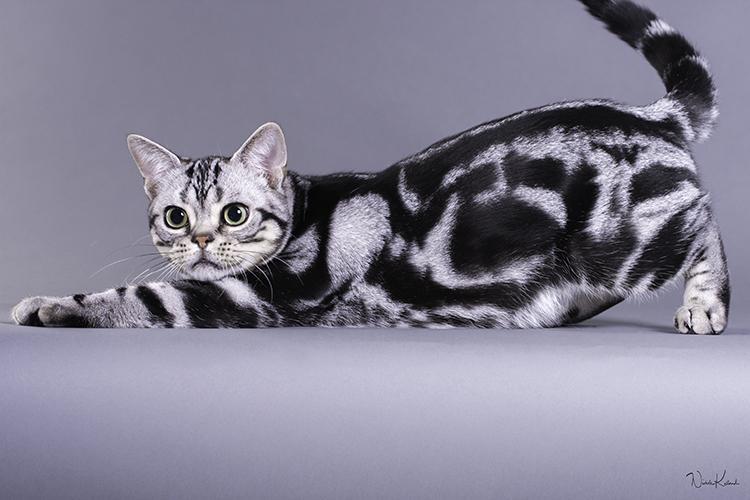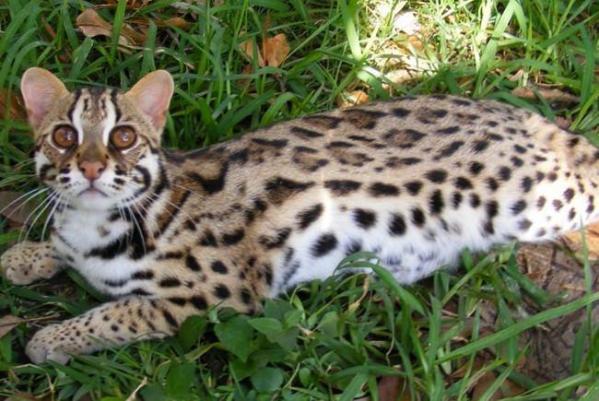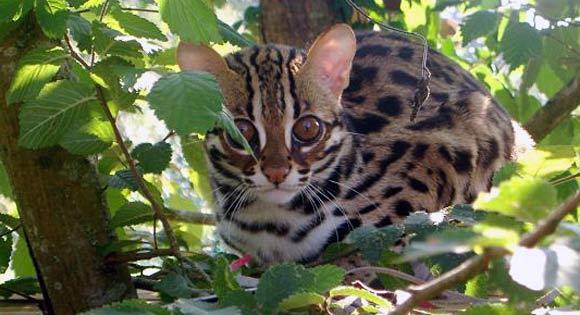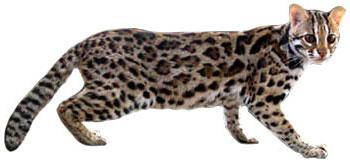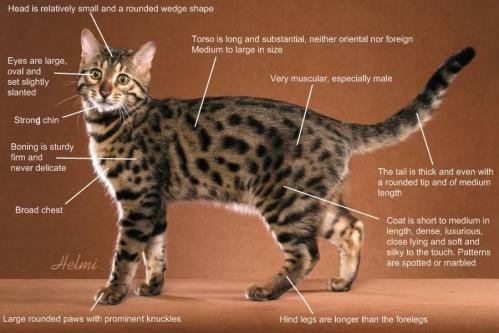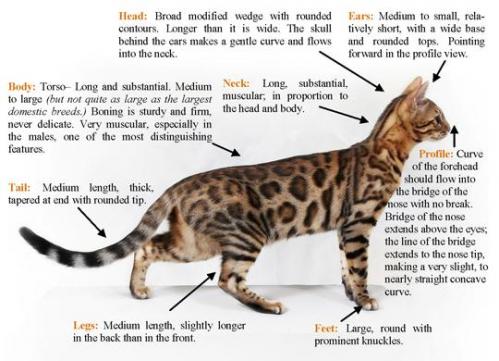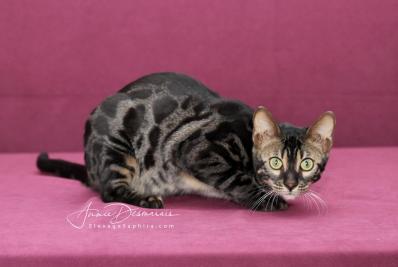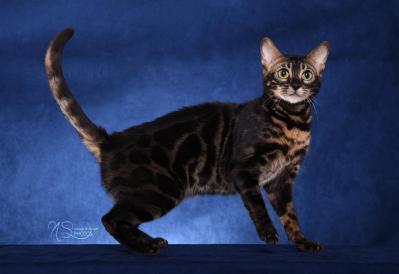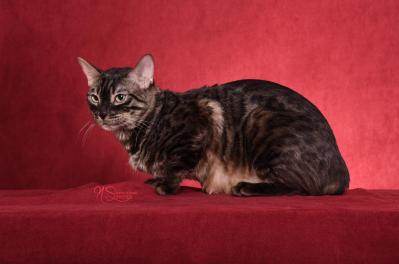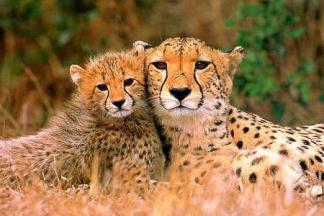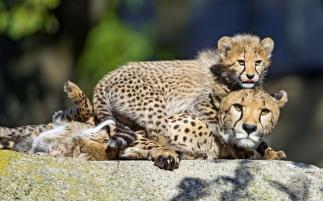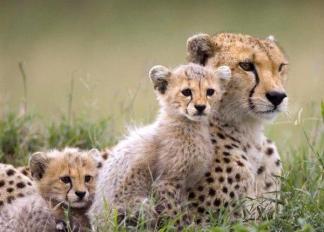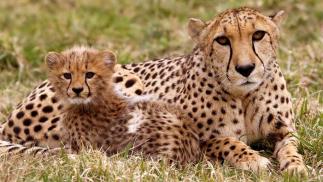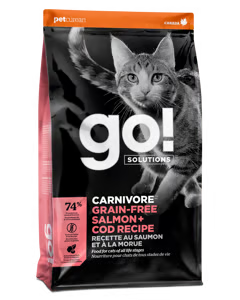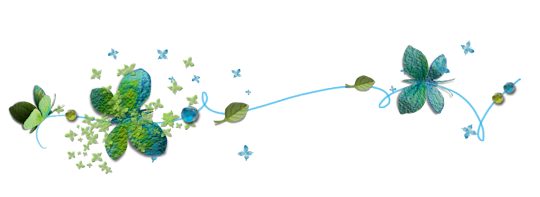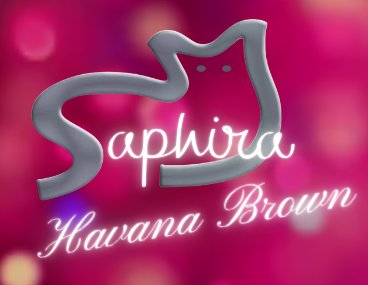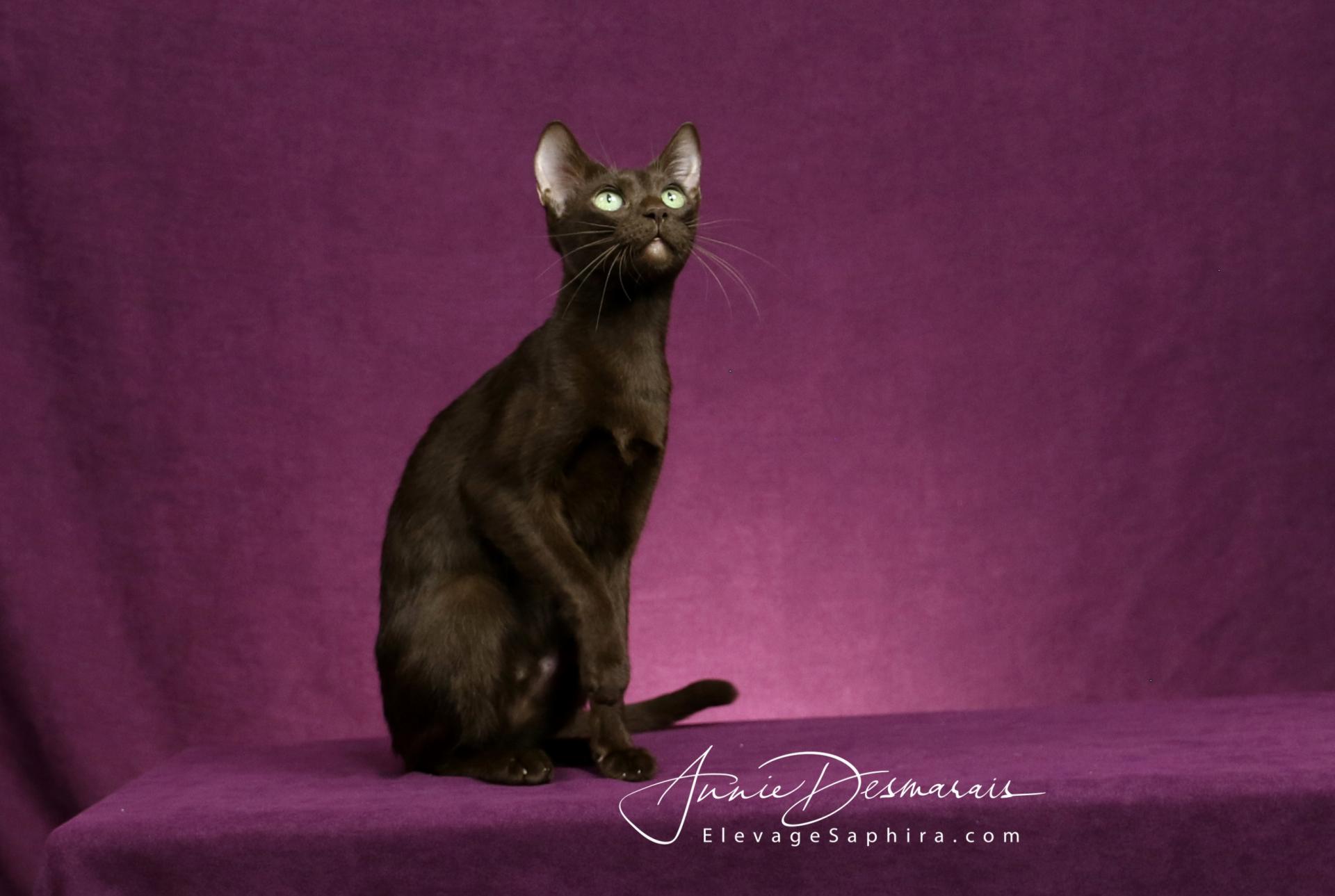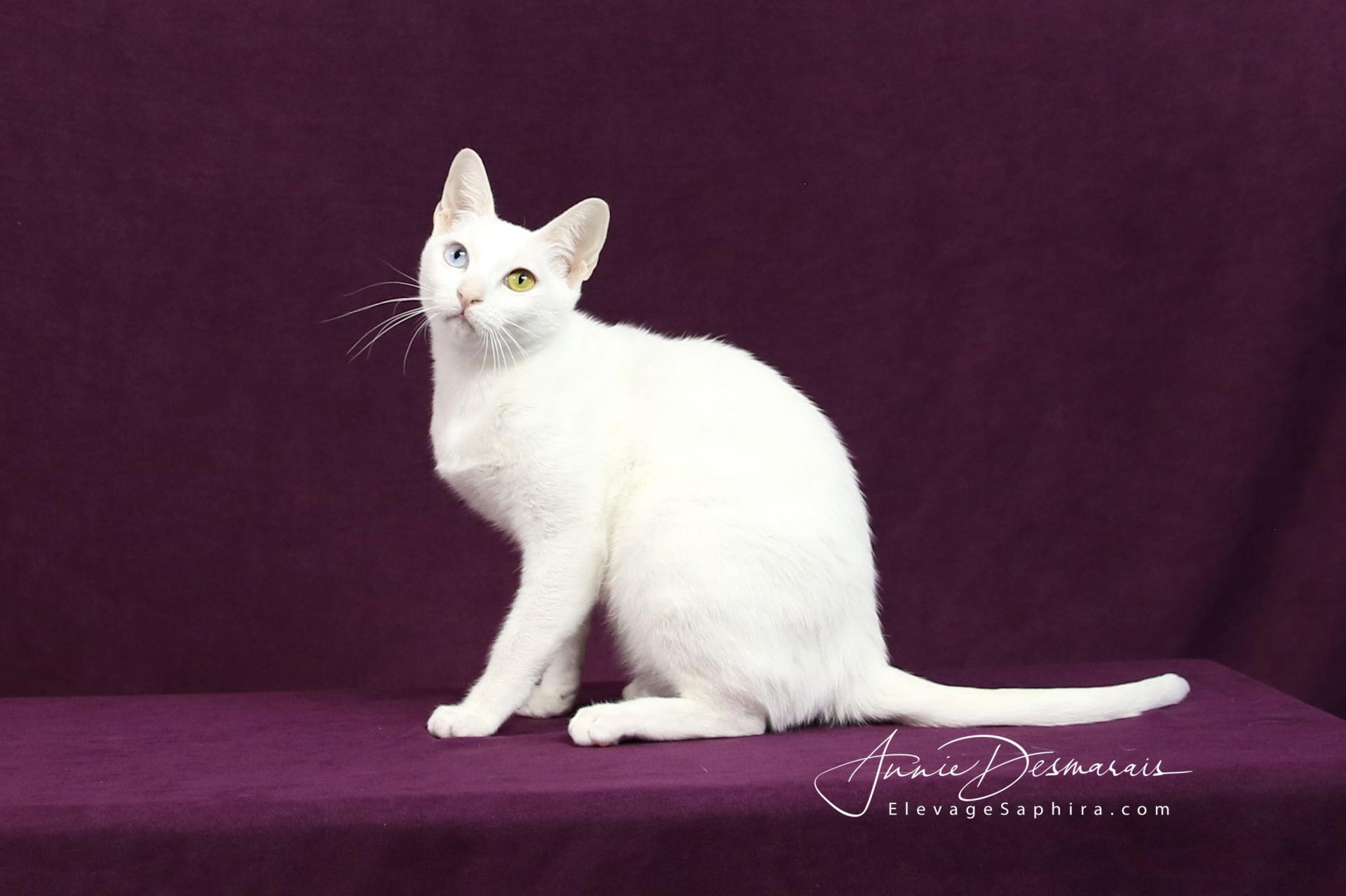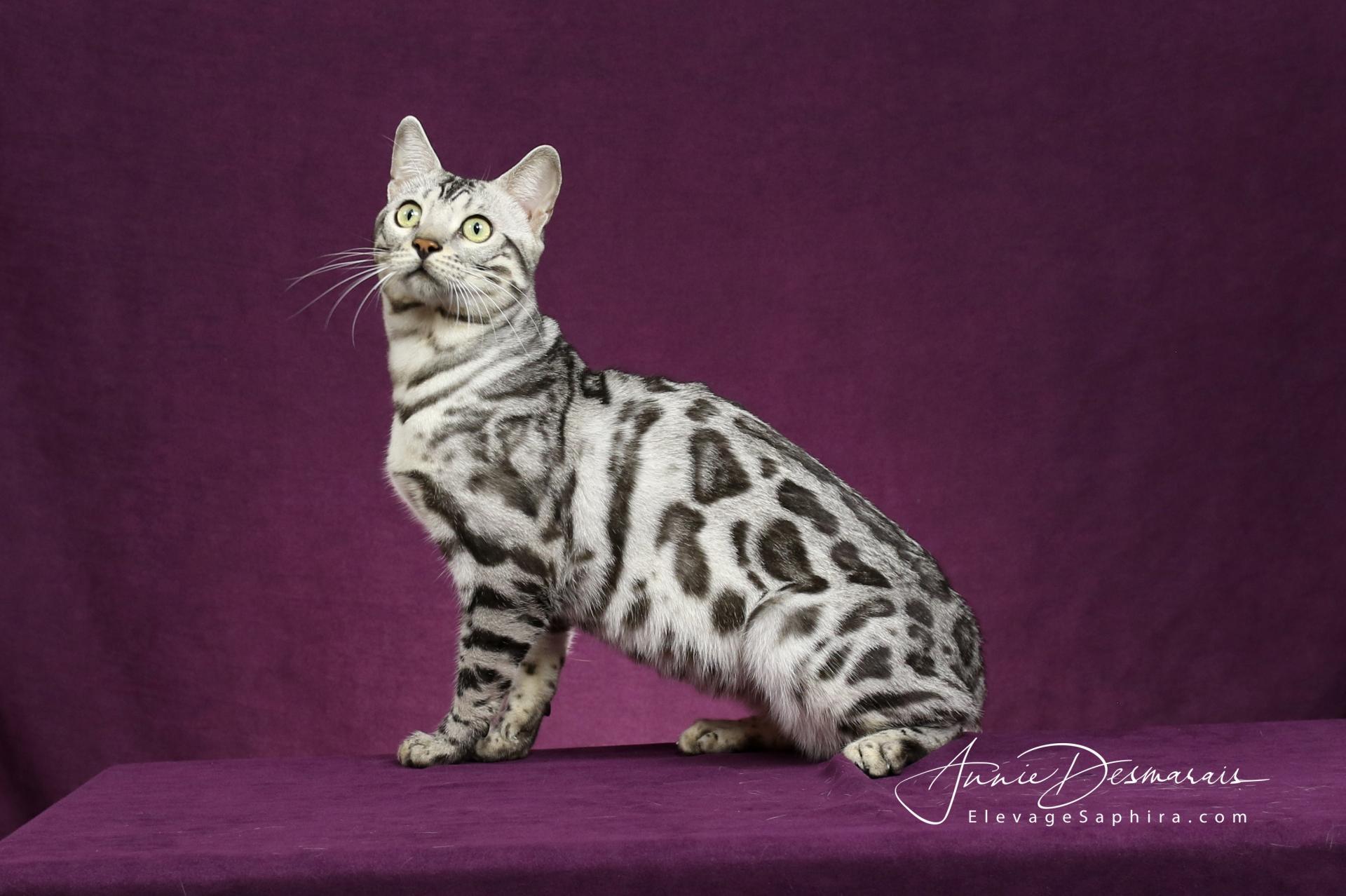Bengal - The Breed
The Origins
The cat breed "Bengal" is a breed that was created by Mrs. Jean Mill, a geneticist from California. Indeed, the development of the breed began in 1963, and is the result of a cross between an American Shorthair cat (see photo below) and a female Asian Leopard cat (Latin name: Felis Prionailurus Bengalensis). The American Shorthair is a cat of "natural" breed, that is to say that it is not the result of crossbreeding made by humans. The American Shorthair can also be described as a "robust" cat, a working cat, because of its constitution.
The Felis Prionailurus Bengalensis is a small wild leopard (living in trees) found in Asia and particularly in the province of Bengal. See pictures below.
For Mrs. Mill, the main goal of this new breed was to create a cat with the wild appearance of a leopard, while having the character of a domestic cat.
Ms. Mill was assisted by UC Davis in California in her hybridization process, which was not easy, but eventually resulted in a wild looking cat with a domesticated temperament. In order to do this, there were also crosses with Egyptian Mau, Burmese, Abyssinian and Siamese cats, in order to get certain characteristics of these breeds, and also in order to diversify the gene pool and thus avoid co-inbreeding. Nowadays, these crosses with these breeds are no longer done, and the matings are only made of Bengals with other Bengals.
Since the wild ancestor was named Felis Prionailurus Bengalensis, the new cat breed thus created was named Bengal.
The Bengal was presented for the very first time in cat show at TICA in 1986, in the category ''New breed'', and it is now part of the championship breeds since 1991. The first F1, F2 and F3 generations are still not allowed to be shown in shows because they are considered too wild, and the goal is to obtain a "domesticated" cat. Moreover, the first generations do not bear the name of Bengal because of their too wild character. Indeed, they are rather called "hybrids" because they are "Bengal in the making".
Today's Bengal comes essentially only from the mating of Bengals with other Bengals as mentioned above, since the primary goal of this breed was to create a domestic cat breed with the dazzling looks of a Leopard, a Jaguar and the Ocelots!
The first generations F1, F2, F3,...
Cats born from a litter between a domesticated Bengal cat (F4 generation and above) and the Felis Prionailurus Bengalensis are first generation (either F1 or Foundation 1), and are called "hybrids" since they are "half-wild" cats. The same is true for F2 and F3.
It is only from the 4th generation (F4) and more that a Bengal is considered to be a so-called "domesticated" cat (no longer considered to be a wild cat).
Also, it is legal to own a hybrid Bengal (F1 to F3) or an Asian Leopard (Felis Prionailurus Bengalensis). However, they can only participate in competitions or cat shows from the 4th generation (F4).
Temperament
The Bengal is an intelligent, confident, curious, alert, agile, elegant and graceful cat. The Bengal likes to explore its environment, and you should always keep in mind that it is an active and interactive cat. If you want a "quiet" breed of cat, this is not the breed to adopt because the Bengal likes to move, climb/roost high and interact with its owner as well! In short, it is a "sporty" cat! And they maintain a kitten-like energy, attitude and vigor, even when adult!
Bengals are also formidable hunters, whether it's little ladybugs or butterflies that might be in the house, they will find them!
That said, Bengals are not aggressive and are very affectionate. It is a very sociable cat, which will not hesitate to go and visit, but will remain closely attached to its masters and remain faithful to them.
The Bengal is a breed that is generally very suitable for a family with children. However, as each individual has his own character, it is sometimes necessary to let oneself be guided by one's breeder when it is time to choose a kitten. A good breeder will know how to advise you.
If you take care of him and play with him a lot, he becomes very endearing. If we neglect him, however, he becomes more fearful. Also, Bengals love water to the point of having fun in it, and some Bengals will even go as far as swimming in the water. So don't be surprised to see your Bengal cat at the edge of your bath, wanting to soak its paw during your relaxing moment, or come and play with the water droplets that fall on the floor during your shower, or watch you brush your teeth!
The Bengal likes to be the center of attention. Also, he will not hesitate to attract your attention and "try to chat" with you! Some people are more talkative than others.
Morphology
The Bengal is a medium to large cat with an athletic body, having good bone and muscle structure. Its triangular head is longer than it is wide, and the sides are rounded.
The weight of an adult Bengal can vary from 3Kg to 7Kg approximately:
- 2.75Kg (6.5lb) to 4.5Kg (10.0lb) for females
- 4.5Kg (10.0lb) to 7.25Kg (16.0lb) for Males
The eyes are oval, almost round, and set wide apart. The permitted colors are green, gold, blue and turquoise, depending on the color of the coat.
The nose must be broad and the cheekbones high and well protruding. The ears are medium to small in size, and are rounded at the tip, pointing forward.
The tail is of medium length, thick at the base, barely tapering to a rounded tip. The legs are well muscled and have a robust bone structure. The paws are large and round, and have prominent toes.
Bengal Colors and Patterns
All Bengals have a Tabby pattern in addition to the Spotted or Marbled pattern as the case may be. This said, we can observe in all Bengals a ''striped'' marking (typical of tabby cats) on the face, on the front of the body and on the outside of the legs. The belly, the throat and the inside of the legs should be slightly lighter in color.
There are 2 patterns available, the Rosette Bengal (commonly called Spotted), and the Marbled Bengal (Marbled).
The Marbled is close to the pattern of the longiband panther (see photo on the right), and is a derivative of the blotched tabby. This was obtained following a selection work of the breeders. This pattern was most likely inherited from its American Shorthair ancestor, at the beginning of the breed.
As for the rosettes, there are several types of rosettes, whether spots, open rosettes, arrowheads, or closed rosettes.
At Saphira Cattery, we have chosen to produce only kittens with closed rosettes, having an incredible contrast because, according to us, this is what the evolution of this magnificent breed should aim at!
As far as colors are concerned, there is of course the Brown Spotted (or Marbled) Tabby, which is the "classic" color according to us, since it reminds without a doubt the coat of a leopard! The only 2 possible and accepted eye colors for the Bengal Brown Spotted are green and gold.
At Saphira Cattery, we continue to work on this color by striving to have a very golden background color and chocolate brown to black rosettes, like our retired cat Saphira June. And this is the closest thing to Leopard color!
For those who want a "red" Bengal cat, this is not what we offer, because we know from our experience that this color ages poorly and loses contrast. Indeed, with time, the color of the rosettes and the background color end up being in the same hues, and the rosettes are no longer as easily distinguishable... The ''WOW'' effect of the coat is no longer there after a few years. Moreover, the orange hues are reminiscent of the Tiger, and not the Leopard! ;-)
Then comes the family of colors ''Snow'', which is subdivided into 3 colors. There can be slight variations in colors but generally, we can observe this:
- Seal Point Spotted (or Marbled) Tabby. The background of the coat of these cats is usually white, and the spots can vary from very light gray to slightly beige. Cats of this color must have blue eyes. A very quick and easy way to know if the cat really has blue eyes is to observe a red reflection in intense light, such as a camera flash. Historically, this color gene comes from the crossbreeding that was done with the Siamese at the beginning of the breed.
- Seal Mink Spotted (or Marbled) Tabby. Cats of this color have a creamy beige background color, and the spots are usually coffee beige. The eyes of Bengals Mink cats must be Turquoise (Aqua). This color comes from both Siamese and Burmese.
- Seal Sepia Spotted (Marbled) Tabby. Bengal Sepia are the darkest ''Snow''. Generally, the background of the dress is beige and the spots are coffee color, without being ''brown-black'' as in Brown Spotted. The eye color of Bengal Sepia is the same as for Brown Spotted, either green or gold. This color gene comes from crosses that were made with the Burmese at the beginning of the Bengal breed.
As far as Silver is concerned, it is in fact from a genetic point of view, a Bengal Brown Spotted for which there is no color on the coat. We could imagine the phenomenon by the idea of watching a Bengal Brown Spotted, but in an old black and white TV set. That said, it also explains the appearance of rufus (red brown hair) in some individuals, which may indicate a poor quality of Silver depending on the quantity. The presence of rufus on the nose and patons may be acceptable, but nothing more. If rufous hairs are present on the body and throughout the coat, it is a clear sign of poor quality Silver. Also, if the weather of the cat seems to be beige, it is not a Silver Bengal but rather a Brown Spotted ''cold brown''.
At Saphira Cattery, we strive to have a beautiful quality of Silver, that is to say that the coat is silver, with very black spots, in order to have the best possible contrast.
The last color which is in fact a pattern, is Charcoal! Indeed, Charcoal is wrongly named as a color, but it is really a pattern since it is superimposed on top of a color to give the appearance of a mask and a cape to the cat.
Here are some pictures of our cats Bengal Brown Spotted Tabby Charcoal, and Seal Sepia Spotted Tabby Charcoal.
What is "glitter"?
The glitter is really a unique characteristic of the Bengal coat! It is in fact the presence of very shiny hairs, taking on the appearance of glitter, which are only visible when the bright light catches them... In the Brown Spotted, the glitter will be gold in color, as if gold dust had been sprinkled on the cat. In Silver, the glitter will be silver, while in Snow, the glitter will take the form of "stardust" or like snow shining in the moonlight on a winter night!
Grooming
Bengal requires very little grooming, other than regular cleaning of the ears for some of them, and claw trimming every 16-18 days or so. Also, it is not advisable to brush or comb them too often in order not to damage their coat; brushing has more the effect of ruffling it. Otherwise, a light brushing may be appropriate during seasonal shedding, but nothing more. A period of stress, such as a move, can also accentuate hair loss.
The coat is short, thick, close fitting, and exceptionally soft and silky to the touch: a real fur ! In fact, the softness of a Bengal fur is reminiscent of a rabbit! Bengals shed very little hair. Indeed, this is not scientific, but our personal observation is that Bengals easily shed 50% less hair (and probably even less) compared to a domestic cat.
In kittens, the coat can be a little longer. This is the "Fuzzies" period.
Fuzzies
At a certain period, kittens have long, messy and shaggy hair, rather dull hairs that blur the color and pattern of their coat. In the wild leopard, this period of "fuzzies" is used to camouflage the babies from possible predators.
This period can last until the age of 6 months. Thereafter, the coat, the pattern and the contrast will be defined until the age of 1 year. And it is necessary to count 1 more year before the Bengal has its perfect color and its well defined pattern.
See below some pictures of young cheetahs showing the aspect of the "fuzzies".
Food
The Bengal being an energetic cat, it goes without saying that its diet must be of superior quality, and high in protein as well. Basically, the cat is a carnivore just like the Asian Leopard, the ancestor of Bengal. Also, we must pay special attention to the kind of food we give to our Bengals.
Also, the choice of food is really very important for Bengals... It is an "exotic" breed and the first generations come from the Asian Leopard. Consequently, the use of food containing corn and cereal grains (such as wheat, barley and oats) is usually not recommended by breeders. Cats are first and foremost carnivores...
Therefore, it is preferable to use a food made from meat, fruits and vegetables. It is also important to ensure that the food does not contain corn in any form (corn, ground yellow corn, corn gluten, cornmeal, etc...). Indeed, food containing corn and/or cereal grains, to a Bengal, may cause him/her repeated diarrhea, a bit like people who suffer from celiac disease (gluten intolerance). It is not pleasant for the cat, and it is not pleasant for the owner when the cat puts its paws in its soft stools and makes traces out of the litter box (...). Blood may also appear in the stool after 3-4 weeks, a clear sign of irritation in the intestine.
Foods made from fish can also cause soft stools in some cats. Therefore, avoid formulas made with fish, salmon, tuna, etc., as much as possible.
Is Bengal a hypoallergenic cat?
Many people write or call us to find out if Bengal is hypoallergenic. The answer is no, Bengal is not a hypoallergenic cat breed.
Let's set the facts about Bengal allergies... The majority of people who are allergic to cats, are in fact allergic to a protein that is contained in their saliva (not necessarily to pet hair). And since cats (including Bengals) lick themselves to clean their fur, they deposit saliva on their hair. Therefore, Bengal is not hypoallergenic.
Also, people suffering from cat allergies have come to visit us and some of them have reacted quite strongly. It always depends on the type of allergy you suffer from, i.e. whether it is of the respiratory type (with asthma attacks), or of the topical type (with sneezing, watering and/or tingling of the eyes, skin etc...), and also on the intensity of your allergies (not very allergic or if you react the moment you enter a room in which there is a cat...).
It is certain that Bengals do not have "undercoat" and that their coat is more similar to "fur" than to the coat of a regular cat (we are referring here to the texture of the hair). Also, they shed much less hair than a domestic cat for example (possibly 50% less hair than a domestic) or a cat of another breed. The fact that the Bengal loses less hair than another cat, makes it a good companion for some "low level" allergic people. Also, we always have the possibility to discipline ourselves to wash our hands after having petted the cat, which gives us an additional chance to reduce the undesirable effects of allergies (ex.: carrying our hands at face and eye level without having washed our hands beforehand...). For respiratory type allergies (with asthma attacks), it is more complicated and it is less likely that the allergic person will not react.
Some breeders guarantee that Bengals are hypoallergenic, but we assure you that this is not true ...
Some time ago (before COVID-19), we hosted a co-worker and his (moderately allergic) spouse. The lady felt the reactions only during the night and early the next morning of her visit with us .
Also, when allergies involve a child, we are not inclined to show or sell a kitten, because there is too much risk that the kitten will have to be relocated if it doesn't work out in the short to medium term... It is certain that when it concerns an adult (compared to a child), he knows the degree of his allergies and he can judge by himself what he is ready to accept as symptoms (at the level of his personal tolerance). But he must be aware that he will experience allergy symptoms at certain times, such as during periods of fatigue or stress, and that the intensity of his symptoms may also vary and worsen over time.
Otherwise, there is the Siberian, another breed of cat completely different from the Bengal. Siberians are known to be hypoallergenic, and most of them do not have the protein, which causes allergies, in their saliva. This might be an option, but it doesn't always work, especially for people who are "very allergic" to cats.
Last edited: Sunday, 17 august 2025
